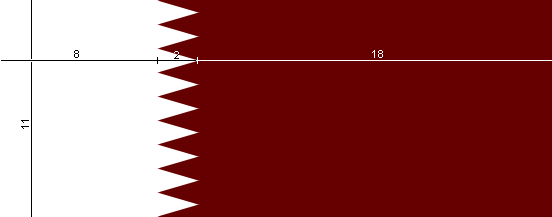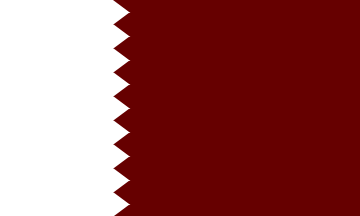![[Qatar]](../images/q/qa.gif) 11:28
11:28
 image by Zoltan Horvath, 5 September 2024
image by Zoltan Horvath, 5 September 2024
Last modified: 2025-08-16 by ian macdonald
Keywords: qatar | asia | serration | zig-zag | indented | persian gulf | diamonds: 10 (red) |
Links: FOTW homepage |
search |
disclaimer and copyright |
write us |
mirrors
![[Qatar]](../images/q/qa.gif) 11:28
11:28
 image by Zoltan Horvath, 5 September 2024
image by Zoltan Horvath, 5 September 2024
Official Name: دولة قطر [Dawlat Qaṭar], State of Qatar
Short Form: قطر [Qaṭar], Qatar
Capital: Doha
Flag Adopted: 09 Jul 1971
Coat of Arms Adopted: 1976
Description: Maroon flag with a white serrated (zigzag) stripe at the hoist
Proportions: 11:28 (very often 2:3 or 3:5)
Use: On land, national, civil and war flag, at sea, national, civil and war ensign.
Colour-approximate specifications (as given in Album des
Pavillons [pay00]):
The flag was defined in 1949 as being "Qatar Maroon" - this being an official
confirmation of of the the (previously unofficial) effect of strong sunlight on
the local red dyes - but no enquiries I have made over the last few years have
yielded anything further in the way of either an official colour definition or
confirmation/otherwise of the original reason for its adoption?
My own spec sheet follows the Albumís suggestion of Pantone 222C, but I have
absolutely no idea of its accuracy?
Christopher Southworth, 14 February 2012
It looks like 102:0:0.
Eugene Ipavec, 25 February 2012
A few items about flags found here and
there in Arab newspapers and websites:
Since 25th May 2011 the six GCC
countries decide to fly the GCC
flag alongside
their national flags according to the decision by the origanization.
News with/without pictures, from Arabic websites (can be translated!):
Bahrain:
http://gulfnews.com/news/gulf/bahrain/bahrain-to-fly-gcc-flag-alongside-its-own-1.811541
Kuwait:
http://alwatan.kuwait.tt/ArticleDetails.aspx?Id=113125
Oman:
http://www.arrouwad.net/news/2011-01-17-21-12-19/2011-01-17-21-16-01/6324-2011-05-25-23-45-28.html
Qatar:
http://www.alarab.com.qa/details.php?docId=189552&issueNo=1257&secId=16
Saudi Arabia:
http://www.aleqt.com/2011/05/25/article_542200.html
UAE:
http://www.alittihad.ae/details.php?id=50338&y=2011
Various pictures:
http://www.3rabpet.com/vb/showthread.php?t=310995&page=1
Jalal Muhammed, 11 February 2012
Qatar has adopted a new law protecting the national flag.
"Qatar has issued a new law that stipulates heavy fines and prison terms for
failing to show due respect to the national flag. The flag law was issued by the
Emir Shaikh Hamad Bin Khalifa Al Thani one day [17 December] before Qatar
celebrates its National Day. "The law stipulates that without prejudice to a
more severe penalty provided by another law, a person shall be punished by
imprisonment not exceeding three years, and a fine not exceeding 200,000 Qatari
riyals, or either of them," Qatar News Agency (QNA) said.
The legal action covers "all those who insult the national flag publicly in any
way by tearing it or by any act suggestive of contempt or hatred or lack of due
respect," the official agency said.
The law prohibits adding words, images or designs to the flag or using it for
commercial purposes or as a brand or for the purpose of advertising.
The national flag should be saluted by military personnel during hoisting or
lowering and during military parades, QNA said. [...]"
Source:
http://gulfnews.com/news/gulf/qatar/qatar-issues-flag-law-1.1120405 - "Gulf
News", 18 December 2012
Ivan Sache, 06 January 2013
Law 14 (2012) "On The Flag of Qatar" (passed 12/16/2012 or 02/03/1434 in the
Islamic calendar) contains a very detailed specification sheet for the flag. It
still uses 11:28, but further defined the size of the nine serrations on the
flag. The Pantone color of the flag was further defined as 1955 C (past
government publications used 222 C, so these are the most current I can find).
The
sheets (Arabic) also contains specifications for flags that are made for
indoor or outdoor use, and when they are made in other ratios for overseas use
(1x2, 3x5, 2x3) and have specifications for all of those ratios. Another
interesting note is when the flag is made for other odd ratios (6x13 for Rwanda,
10x19 for the US or 5x8 for others), the flag is required to be trimmed.
Zachary Harden, 31 May 2013
I was just looking up information on Qatar's flag on the Ministry of
Information page. The
page is in Arabic and hasn't crossed over into English, but you can verify it if
you know another Arabic linguist. According to the Ministry, the white
symbolizes peace. The maroon (literally the color of jujube) symbolizes blood
that was shed in Qatar's past wars, especially in the second half of the 19th
century. The nine points symbolize Qatar's position as the 9th emirate of
Trucial Oman
under British rule. (Generally only those 7 that did unite to form the
United Arab Emirates are considered
Trucial Oman. The eighth would be Bahrain.)
Chris Steinitz, 22 February 2006
I am wondering from when this interpretation is? The number of points has
certainly changed over time (image from Flaggenbuch [neu92] shows 10 white
points, for instance), and this kind of interpretation of symbols (red for shed
blood and white for peace) is probably rather new. Since when is the colour
known as "colour of jujube", and why? Is the number of points fixed anywhere in
a regulation, and since when?
M. Schmöger, 22 February 2006
Christorpher is right enough... none out of my few sources gives a clearly
explanation whether points and maroon.
Here your are what my sources says about the matter:
"Due the Qatari flag was too alike to that of Bahrain, about 1949 it was
officially approved to change the flag from red to chestnut-redish (brown). The
tooth-like form of the white stripe has no meaning in particular, it
corresponds to decorative things only".
Source: Banderas y Escudos del Mundo, ED. América SA. Spain, 1986. P.
183a.
"(...) Her flag was then very similiar to that of Bahrain, but in 1949 the
problem was solved by Qatar replacing the red by a curious deep maroon. This may
have been a matter of official recognition following long after the fact, since
the red vegetable dyes used to colur the flag may well have faded to a shade
like this in the heat of the desert sun."
Source: Flags of the world, Eve Deveroux, Cescent Books, NJ 1992.
"The serrated border [after the Bahrain flag] is still there, but the colour of
the red has become deeper, to a shade now know as 'Qatar maroon', (...)
These changes were made official in 1949. (...)".
Source: Flags of the world, William Crampton, Dorset Press, NY 1990.
"In 1949, the plain flag came into use, and the color was alteredfrom red to
maroon. This color is based on the way in which red pigment made from local
vegetable dyes reacts to the sun. The color and shape are official."
Source: Flags, Ken Alexander, Flag Research Center, Winchester, 1992.
Juan Manuel Gabino Villascán, 22 February 2006
Law No. 14 of 2012 Concerning the Qatari Flag:
https://www.customs.gov.qa.
The Ministry of Foreign Affairs also has a page about flag and emblem with illustrations:
https://mofa.gov.qa
This page gives RGB values of flag color: https://www.qatarliving.com.
Zoltan Horvath, 5 September 2024
Other sources for colors:
The protocol manual for the
London 2012 Olympics (Flags and Anthems Manual
London 2012 [loc12]) provides recommendations
for national flag designs. Each
NOC was sent an image of the flag,
including the PMS shades, for their approval by LOCOG. Once this was obtained, LOCOG produced
a 60 x 90 cm version of the flag for further approval. So, while these specs may
not be the official, government, version of each flag, they are certainly what
the NOC believed the flag to be.
For Qatar: PMS 222 purple. The vertical flag is simply the horizontal version
turned 90 degrees clockwise.
Ian Sumner, 10 October 2012
The Flag Manual - Beijing 2008 gives Pantone color: PMS 195 (maroon).
The Album des Pavillons 2000 [pay00] (Corr. No.
4.) gives approximate colors in Pantone and CMYK systems:
Brown: Pantone
222c, CMYK 0-100-15-60
Blue: Pantone 287c, CMYK 100-70-0-10
Yellow:
Pantone 116c, CMYK 0-10-95-0
Green: Pantone 390c, CMYK 20-0-100-5
The
Album des Pavillons 2023 already specifies the colors of the flags in three
color systems:
Blue: Pantone 287c, CMYK 100-83-7-0, RGB 0-53-152
Brown:
Pantone 222c, CMYK 39-96-36-47, RGB 108-25-63
Yellow: Pantone 116c, CMYK
0-19-93-0, RGB 255-206-0
Green: Pantone 390c, CMYK 38-11-100-0, RGB 178-188-0
Vexilla Mundi gives colors in Pantone
system: PMS 1955C (maroon), and PMS White.
Wikipedia illustrates the flag, and
construction details, refers to Flag Law, and gives color specification as
follows:
Maroon: Pantone 1955 C, RAL 3003, CMYK 0-85-59-46, Hex #8A1538, RGB
138-21-56
White: Pantone White, RAL 9016, CMYK 0-0-0-0, HEX #FFFFFF, RGB 255-255-255
Flag Color Codes gives the following color values:
Maroon:
Hex #8A1538, RGB 138-21-56, CMYK 21-100-7-52, Pantone 222, RAL 3003
White:
Hex #FFFFFF, RGB 255-255-255, CMYK 0-0-0-0, Pantone N/A, RAL N/A
Zoltan Horvath, 5 September 2024
 image by Željko Heimer and Eugene Ipavec, 07 December 2002 and 19
February 2012
image by Željko Heimer and Eugene Ipavec, 07 December 2002 and 19
February 2012
Album des Pavillons [pay00] provides the construction details as 11:(8+2+18). There are nine white points in the serration.
Željko Heimer, 07 December 2002
Despite the near-vilification of this flag over its individualistic approach to proportions (11:28, a reflection of a "do your own thing" view of national policy?), there is a fascinating story here.
At first glance, the Qatar flag seems remarkably similar to the flag of Bahrain. Both have the distinctive serrated margin between the white band at the hoist and the "red" fly. The proportions set them apart (Bahrain 3:5) and the colors differ, with Bahrain being a standard "British" red (they, after all, had a strong and "involved" British adviser throughout the 1930s) and Qatar the distinctive "maroon." This similarity reflects an intertwined history.
To make a long and involved story very short, the histories of the two states have overlapped and occasionally collided since the 18th century. The distinctive Qatari flag emerged in the 1930s (official adoption of the maroon color came about 1949).
Bahrain's flag as we know it now was formally adopted in 1932 and the Qatari differences in size and color (said to be what becomes of red as it fades in the Gulf sun – a fanciful tale) seem to be largely an effort to make the Qatar flag different from the Bahraini
banner.
Ed Haynes, 29 January 1996
 3:5
image by Eugene Ipavec, 28 February 2012
3:5
image by Eugene Ipavec, 28 February 2012
Unofficial Qatari flags with more conventional proportions than the official 11:28 are in common use, like this 3:5 example.
This is
photo of a (very large) 3:5 flag of Qatar. Our page already notes that more
conventional proportions than the official 11:28 are in common use.
Eugene Ipavec, 28 February 2012
2022.gif) image by Zoltan
Horvath, 5 September 2024
image by Zoltan
Horvath, 5 September 2024
Qatar adopted a new version of the national emblem on 15 September 2022. This
page shows the evolution of national emblems:
https://gba.gco.gov.qa/guidelines/our-story
There is a short video
about historical emblems and new emblem symbolism:
https://www.youtube.com
Zoltan
Horvath, 5 September 2024
The new emblem also features the historical Qatari symbols found on the previous
emblem: the founder's sword, palm trees, sea and the traditional boat, except
all in the maroon colour placed against a white backdrop.
Christopher
Southworth, 9 October 2024
1976.gif) image by Zoltan
Horvath, 5 September 2024
image by Zoltan
Horvath, 5 September 2024
The previous national emblem adopted in 1976 shows two crossed, white, curved
swords in a yellow disk. Between the swords there is a sailing boat (dhow)
sailing on blue and white waves beside an island with two palm trees. The circle
is surrounded by an additional circle, which is divided horizontally between the
two colors of the flag. In the white section, the name of the state of Qatar is
written in black and in Arabic, while in the maroon section, the country's
official name is written in a white old English font.
Zoltan
Horvath, 5 September 2024